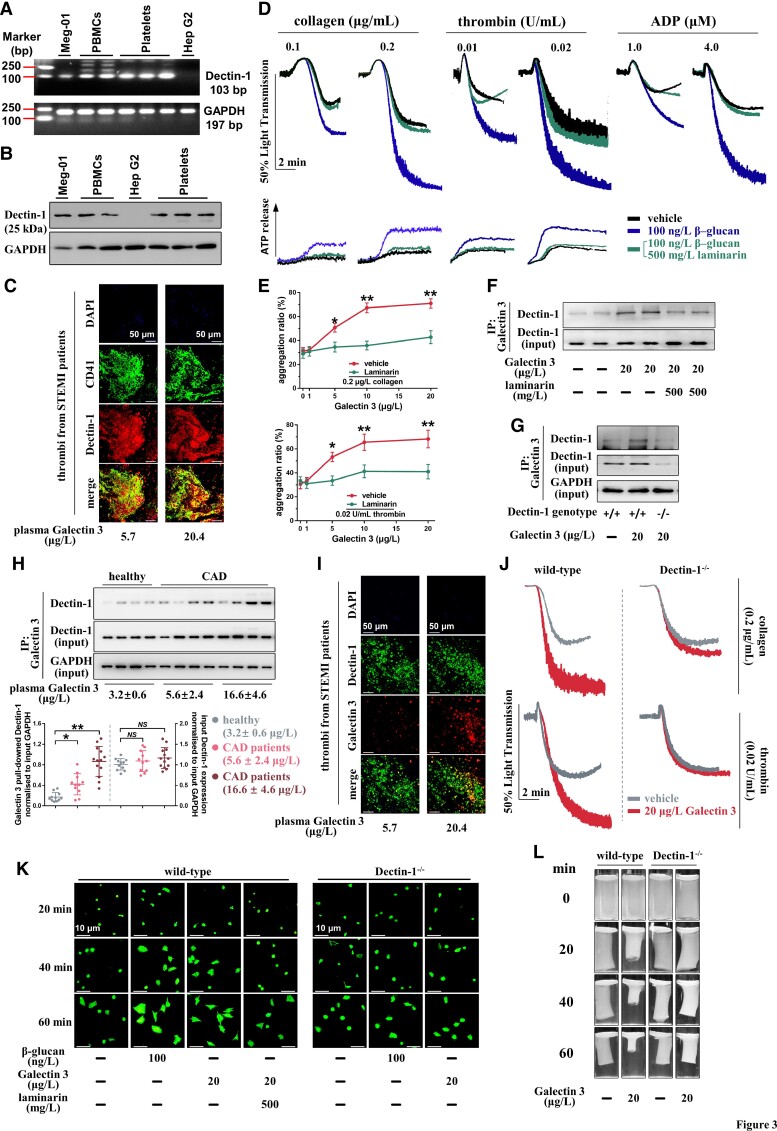Figure 3.
Galectin-3 potentiates platelet activation by binding to platelet Dectin-1. (A) RT-PCR detection of Dectin-1 in healthy human platelets and the human megakaryoblast cell line Meg-01. (B) Western blot detection of Dectin-1 in healthy human platelets and Meg-01 cells. For (A) and (B), the human liver cell line Hep G2 was used as a negative control. Three platelet samples and two peripheral blood mononuclear cell samples were purified from different healthy blood samples. (C) Dual-immunofluorescence staining showed localization of Dectin-1 (Dectin-1+) on platelets (CD41+) within thrombi aspirated from ST-elevation myocardial infarction patients with high plasma Galectin-3 levels (10.4–22.3 μg/L; n = 5) and low plasma Galectin-3 levels (5.1–7.2 μg/L; n = 5). Scale bar = 50μm. (D) β-glucan potentiated platelet aggregation induced by collagen, thrombin, or adenosine diphosphate, as well as adenosine tri-phosphate release induced by collagen or thrombin using healthy washed platelets. Laminarin abolished the potentiating effect of β-glucan. Representative results and summary data (see Supplementary material online, Figure S5) of four experiments are presented. (E) Laminarin reversed the potentiating effect of Galectin-3 on platelet aggregation induced by collagen or thrombin using healthy washed platelets. Summary data of four experiments are presented. For (D) and (E), washed platelets from healthy subjects were pre-treated with 500 mg/L laminarin for 5 min and then treated with β-glucan (100 ng/L; 5 min) or recombinant Galectin-3 (1–20 μg/L; 5 min) before stimulation by collagen, thrombin, or adenosine diphosphate. (F) Co-immunoprecipitation shows that Galectin-3 bound to Dectin-1, which was blocked by laminarin. Representative results of at least four experiments using platelets from different healthy subjects are presented. (G) Galectin-3 bound to Dectin-1 in wild-type platelets, whereas the binding was reversed by Dectin-1 deficiency. Representative results of at least four experiments are presented. For (F) and (G), washed platelets were pre-treated with 500 mg/L laminarin for 5 min and then treated with recombinant Galectin-3 (20 μg/L) for another 5 min. (H) Binding of Galectin-3 to Dectin-1 increased in platelets from coronary artery disease patients, whereas the input Dectin-1 expression remained unchanged. The coronary artery disease patients with high plasma Galectin-3 levels (16.6 ± 4.6 μg/L) presented the highest binding of Galectin-3 to platelet Dectin-1. Representative results and summary data are presented. Each circle represents the result of a different individual from healthy subjects (n = 11), coronary artery disease patients with low plasma Galectin-3 levels (n = 11), or coronary artery disease patients with high plasma Galectin-3 levels (n = 13). (I) Co-localization of Galectin-3 and Dectin-1 was increased in thrombi from ST-elevation myocardial infarction patients with high plasma Galectin-3 levels (10.4–22.3 μg/L; n = 5) compared with those from ST-elevation myocardial infarction patients with low plasma Galectin-3 levels (5.1–7.2 μg/L; n = 5), whereas total Dectin-1 expression were similar. Scale bar = 50μm. (J) Recombinant Galectin-3 potentiated platelet aggregation induced by collagen or thrombin using platelets from wild-type mice but not from Dectin-1−/− mice. Representative results and summary data (see Supplementary material online, Figure S7) of at least four experiments are presented. (K-L) Recombinant Galectin-3 potentiated platelet spreading (K) and clot retraction (L) using platelets from wild-type mice, which was blocked by laminarin. However, Galectin-3 did not potentiate platelet spreading using platelets from Dectin-1−/− mice. Representative results and summary data (see Supplementary material online, Figure S8) of at least three experiments are presented. Statistical analyses were performed using one-way ANOVA followed by Dunnett's multiple comparison test in (H) and unpaired two-tailed Student's t-test in (L). Repeated measures one-way ANOVA followed by Sidak's multiple comparison test in (D). Two-way ANOVA followed by Sidak's multiple comparisons test was performed in (E), (J), (K), and (L). NS, no significance; *P < 0.05; **P < 0.01.

